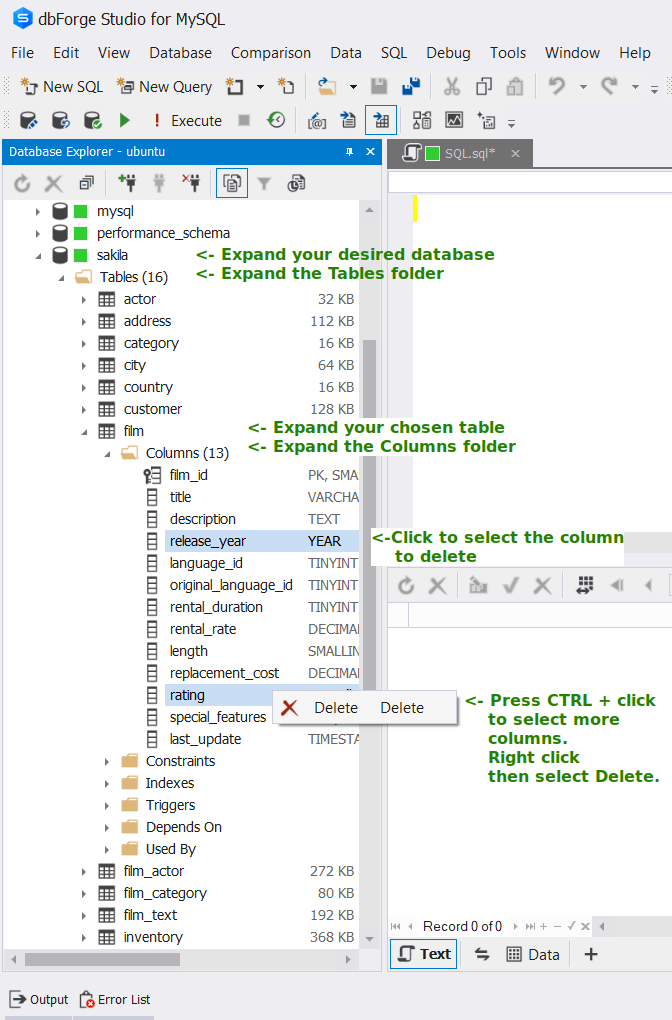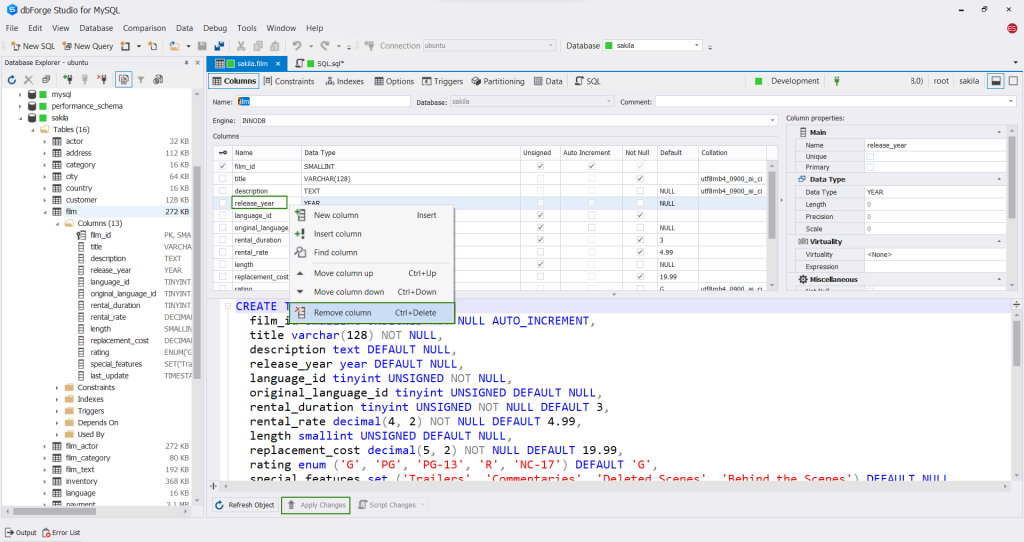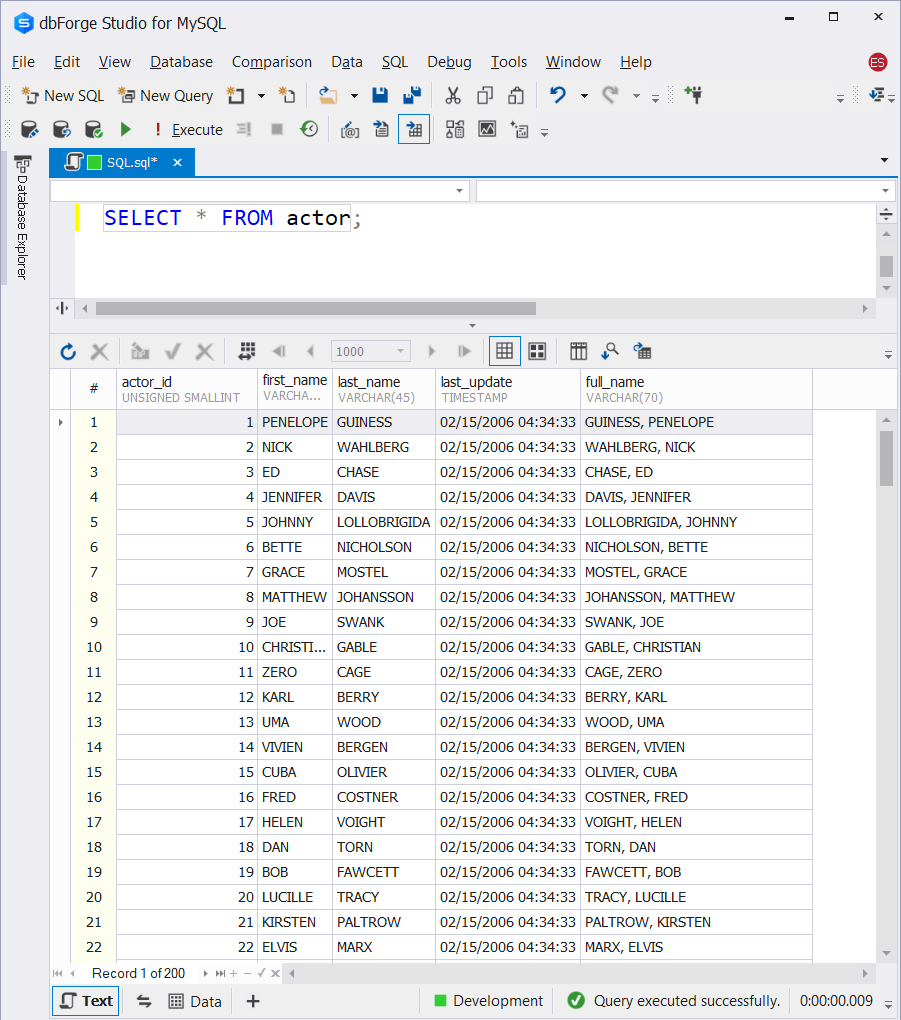The MySQL delete column might sound pretty straightforward. You simply run the DROP COLUMN command, and poof! It’s gone.
However, there’s a catch. The impact of this seemingly simple action can be more far-reaching than you might have anticipated.
Deleting a column with dependencies can lead to a cascade of issues. But fear not! It’s not as daunting as it sounds, and you’ve got this.
That’s why we’ve put together the ‘2023 Ultimate Easy Guide’ you are reading right now. This will help you navigate the intricacies of MySQL column deletion with confidence. This guide will walk you through the essential syntax and usage of the MySQL delete column. So, if you’re a newbie, this is for you.
Once we are done with that part, buckle up since that’s just the beginning. We’ll dive into advanced topics that reveal the complexities of column dependencies.
Here’s our map to this journey:
- Delete a Column in MySQL: Know the Syntax and Usage
- MySQL Delete Column Command-Line Examples
- Delete a Column in MySQL Using a GUI Tool
- MySQL Delete Column: How to Deal with Dependencies
- MySQL Delete Column Best Practices
With this comprehensive guide, you’ll be well-equipped to handle MySQL column deletion.
Let’s begin.
Delete a Column in MySQL: Know the Syntax and Usage
When it comes to MySQL Delete Column, understanding the syntax and usage is your foundation. It’s like learning the basic moves in a dance; get this right, and you’re off to a great start.
The syntax for deleting a column is straightforward. To delete a column, use ALTER TABLE and DROP COLUMN as demonstrated below:
ALTER TABLE table_name DROP COLUMN column_name; Here, table_name is the name of the table from which you want to remove a column, and column_name is the name of the column you wish to delete.
Now, for the usage part, it’s all about knowing when and why you’d use this command. Picture it like a toolbox – you need the right tool for the right job. Use DROP COLUMN when:
- You’ve realized that a column holds redundant or unnecessary data. And you want to clean up your database (Data Redundancy).
- You need to remove sensitive data from your database to ensure privacy and compliance with regulations (Data Privacy).
- You want to optimize your database schema. So, removing outdated or unused columns should improve query performance (Schema Optimization).
- Your application has evolved, and it’s time to restructure your tables for a more efficient data model (Table Restructuring).
With this knowledge, you’re ready to run your first MySQL column deletion confidently.
MySQL Delete Column Command-Line Examples
Now, moving on to practical command-line examples to see this in action. We’ll start with the basics of removing a single column from a MySQL table and then explore more advanced scenarios.
Let’s get started.
Remove One Column in a Table
We are beginning our journey with a fundamental task: deleting one column from a MySQL table. We’ll use the popular Sakila sample database as our playground. I will also use this MySQL version: 8.0.34-0ubuntu0.22.04.1.
Suppose we want to delete a column from the film table. To see the table’s column list, we used DESCRIBE:

Now, suppose we want to delete release_year. Below, you can see the example of a query that will do exactly that:
USE sakila;
ALTER TABLE film
DROP COLUMN release_year; In this example, we’re using the ALTER TABLE statement to change the film table. The DROP COLUMN clause tells MySQL to delete the release_year column.
To confirm the deletion of the said column, you can issue this command again:
DESCRIBE film; The following image shows the results of the DROP COLUMN query. The release_year column no longer exists.

Now, let’s try removing several columns in one go.
Removing Multiple Columns
Removing more columns at once is just as straightforward:
ALTER TABLE film DROP COLUMN rating, DROP COLUMN special_features; In this example, we’re using the ALTER TABLE statement again to change the film table. But this time, we’re using it to drop two columns: rating and special_features. To do this, we stack the DROP COLUMN clauses. By doing so, we streamline the process of deleting more than one column saving our time and effort.
Again, you can confirm the column deletion by using the DESCRIBE command.
But is using the command-line interface not your cup of tea? Let’s try a visual approach in the next section of our guide.
Delete a Column in MySQL Using a GUI Tool
In this section, I’ll be using dbForge Studio for MySQL as my GUI tool. The same commands we used earlier will work in its SQL window. But here, we will use the mouse for deleting one or more columns. And there are several ways to do it.
First, you can delete one or more columns using the Database Explorer:
- Expand the database where the table resides.
- Navigate to the Tables folder and look for the table you need.
- Expand the desired table.
- Expand the Columns folder to show the columns.
- Click a column that you wish to delete. Press CTRL and click another column if you wish to delete more.
- Press the DELETE button on your keyboard. Alternatively, right-click one of the columns and click Delete.

Another way to delete a column in dbForge Studio is by using Table Designer:
- In the Database Explorer, right-click the table you need.
- Select Open Editor.
- Right-click the column you want to delete.
- Select Remove column.
- Repeat steps 3 and 4 to remove more columns.
- Click Apply Changes to save the modified structure.

Now that we’re done with the basics, roll your sleeves up because we’re moving to advance topics on column dependencies.
MySQL Delete Column: Dealing with Dependencies
Let’s proceed with our journey by digging deeper into MySQL column deletion. As we do that, we will encounter an intricate web of dependencies. Removing a column can send ripples all the way across your database. In this section, we’ll explore how to navigate these dependencies like a seasoned sailor in uncharted waters.
Here’s what we will discuss next:
- Delete Column with Foreign Key
- Delete Column Used in Generated Columns
- Delete Column Referenced by Other MySQL Database Objects
- Effects on Application Code and ORM Frameworks When Deleting a Column
Delete Column with Foreign Key
Foreign keys are good for maintaining data integrity. But if you want to delete a column that is also a foreign key, you’re in for a big surprise. Let’s try this one:
USE sakila;
ALTER TABLE film
DROP COLUMN original_language_id; The column original_language_id is subject to a foreign key constraint. Running the above command will trigger the error below:
ERROR 1828 (HY000): Cannot drop column 'original_language_id': needed in a foreign key constraint 'fk_film_language_original' Now, that’s a hassle. However, if you really need to remove this column, you have to delete the foreign key first. Then, run the DROP COLUMN command again.
It is important to keep in mind that foreign keys are there for a reason. And that is to avoid orphaned data and for the sake of the other foreign key benefits. Thus, be careful when it comes to deleting foreign key columns.
Delete Column Used in Generated Columns
Generated columns offer a powerful way to incorporate calculated values based on SQL expressions. They allow you to utilize existing columns within the expression of a generated column. This means you can concatenate VARCHAR columns or create a formula using various DECIMAL or INT columns. In essence, generated columns provide a flexible mechanism for deriving new data from existing information in your database.
Let’s create a full_name column from the actor table in the Sakila database using ADD COLUMN.
USE sakila;
ALTER TABLE actor
ADD COLUMN full_name varchar(70) GENERATED ALWAYS AS (CONCAT(last_name,', ', first_name)) STORED; Here’s what happens when you add this new column:

As you can see above, a brand-new column with data has been successfully added.
But what will happen if you drop the first_name column? Let’s give it a try.
ALTER TABLE actor
DROP COLUMN first_name; Surprise! You will get an error like the one below.
ERROR 3108 (HY000): Column 'first_name' has a generated column dependency. As you can see, removing a column that is used in generated columns requires caution. If that is a must, you must first either remove or alter the generated column associated with it. Once this is done, you can proceed with the DROP COLUMN command.
Aside from foreign keys and generated columns, are there other possible pitfalls within the database? That’s the focus of the next subsection.
Delete Column Referenced by Other MySQL Database Objects
As mentioned earlier, removing a column from your MySQL table isn’t an isolated act. It has a ripple effect that can disrupt other database objects. This includes views, stored procedures, triggers, and functions. The consequences can result in errors, unexpected behaviors, and countless hours of troubleshooting.
Before taking the plunge and deleting that column, take a proactive step. Search for all objects that might depend on it and make a list. This will help you expect and mitigate any issues that might arise post-deletion.
For a more efficient approach, consider leveraging tools like dbForge Studio for MySQL. It can provide a comprehensive list of dependencies linked to the table you plan to change. This invaluable feature allows you to review and manage these dependencies. And also ensure a smoother transition.
For example, let’s say you plan to delete any of the columns in the customer table of the Sakila database. In dbForge Studio for MySQL, you can see the dependencies in the Database Explorer. Look for the customer table and expand the Used By folder. Check it out below:

The above screenshot demonstrates that the rewards_report stored procedure uses all the columns of the customer table. Therefore, removing any of the columns will alter the rewards_report columns too. And if this is a production database, it will definitely enrage your users.
Aside from database objects, deleting a column also affects your application code. It’s an aspect we’ll delve into in the next subsection. So, let’s uncover how these affect your app to overcome potential challenges.
Effects on Application Code When Deleting a Column
When you delete data in your MySQL database, the impact isn’t limited to the database itself; it resonates throughout your application code. If you delete a column, it may cause your application to stop functioning correctly due to potential errors.
Let’s say you’re using an Object-Relational Mapping (ORM) framework. Any class property that references the deleted column will trigger an error.
Here’s where a proactive approach is essential. Before performing any column deletions, review your application code. Identify and change any parts of the code that rely on the column slated for removal. So, this step is crucial to ensure a smooth transition.
The following section will uncover the essentials to make column deletion as seamless as possible.
MySQL Delete Column Best Practices
Mastering the art of MySQL column deletion isn’t about syntax and execution. It’s about applying best practices to ensure a seamless process. The following are valuable insights to make a smooth journey of removing columns.
- Documentation is key: Before deleting any column, maintain comprehensive documentation. Note the reasons behind the deletion, dependencies, and any modifications made to the application code. This detailed record will be your guiding light, ensuring you have a clear understanding of the changes you’ve made.
- Testing ground: Always create a test environment that mirrors your production database. Use it to simulate the deletion process before applying changes to the live system. This will help you anticipate and resolve any unexpected issues.
- Dependency check: Identify and list all dependencies on the column slated for removal. This includes foreign keys, indexes, views, triggers, stored procedures, and application code. Assess the impact of deletion and ensure all necessary adjustments are made.
- Backup your data: Before performing any deletions, take a full backup of your database. This ensures that you have a safety net in case something goes awry during the process.
- Plan for downtime: If your database is in a production environment, plan for a maintenance window. Let stakeholders know when the deletion will occur to minimize disruptions.
- Iterative approach: When dealing with complex dependencies, consider an iterative approach. Remove one layer of dependencies at a time, ensuring the database remains functional at each step.
- Monitor and test post-deletion: After the column removal, monitor the database for any unexpected behavior. Continue testing your application to ensure everything is functioning correctly.
By following these best practices, you’ll navigate the intricate process of MySQL column deletion with confidence.
Takeaways
As we conclude, let’s recap the key takeaways that can guide you toward successful MySQL column deletion:
- Understand the syntax: Master the syntax of the ALTER TABLE statement and the DROP COLUMN clause.
- The ripple effect: Recognize that deleting a column can trigger a domino effect. It will impact other database objects and your application code.
- Proactive management: Thoroughly review and document dependencies before making deletions. And leverage tools like dbForge Studio for MySQL for a comprehensive list of object dependencies.
- Application code vigilance: Be vigilant about the repercussions of column deletion on your application code. Update it as needed to prevent errors and data loss.
- Best practices: Adhere to best practices for dealing with dependencies.
Also, keep in mind that both command-line and GUI methods have their unique pros and cons. So, embrace the strengths of these tools based on your needs. And remember that mastery comes from a blend of knowledge, practice, and vigilance.
Database management also includes other commands as well. Here are some other resources for your skill-building:
- The MySQL ADD COLUMN Easy Guide: How to Make New Table Columns Without the Oops
- MySQL CREATE TABLE vs. T-SQL with Syntax Examples
- How to Delete an Entire MySQL Database






